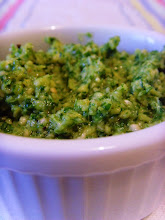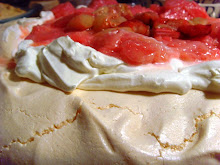
I'm fairly surprised to find that I've not yet posted a recipe for one of my favourite British pudding. Summer pudding is something I make quite frequently during the months when berries are at their glorious best. I make it for several reasons. Firstly, I think it is delicious. Secondly, most other people tend to think it is delicious, hence it is a winner at a dinner party. Thirdly (and this is the exhibitionist in me), people are always rather impressed when you turn a gleaming pudding such as this out of the pudding basin. They seem to think it is a complicated pud to make. I'm happy to let them think that. It's nice to bathe in a little glory once in a while.

The secret is out though. Summer pudding is actually a remarkably simple thing to make. In fact, it was one of the first desserts I ever attempted. Admittedly, it is not quite as simple as my father used to think. One evening when we were congratulating my mother on having turned out the perfect summer pudding, he asked what all the fuss was about. It was surely very simple to make, he said. Surprised that my father felt he could make a summer pudding (his culinary skills extend to making toast, though he does have many other talents), we asked him for his recipe. Well, he said, you take a large loaf of unsliced bread and scoop out all the bread from the middle. You then fill the space up with fruit and leave in the fridge for a day-or-so. Hmmm. Not quite sure that would be the summer pudding of my dreams. I'll stick to my mother's ever-so-slightly more complex version, I think!
I've tried lots of different summer puddings over the years in restaurants and have reached several conclusions. Your tastes may well be different to mine, but for me, summer pudding should be kept simple. Trying to fancy it up just doesn't work (...for me).

First things first. Make one big pudding rather than several little ones. This actually pains me to say it, as I think individual puddings look far prettier. But the ratio is all wrong with an individual pudding. Too much bread and not enough fruit.
Secondly, and this is where things may get controversial, I use plain old medium sliced white, slightly stale, bread. Seriously. I've tried it made with brioche, with thick freshly-baked bread, with all sorts. Nothing works for me as well as a loaf of medium-sliced white bread which is past its best. Fresh bread just doesn't soak the juices up as well. Brioche is too rich and buttery. Delia and I come to blows here. She insists upon high quality bread. Delia and I don't often come to blows, but on this matter I refuse to shift. I'm sorry, Delia. Finally, don't be afraid of the sugar. Remember, raspberries and redcurrants are tart. You want a little tartness in your summer pudding, but not too much. Puddings should be fun, not leave a sour taste in the mouth! Taste, taste, taste as you go - all berries differ in sweetness so I just add the sugar until it tastes right to me.
I find it a little tricky to know what quantity and mixture of fruit to suggest. Purists would insist on just raspberries and redcurrants. They would be horrified at the inclusion of strawberries or - heaven forbid - blackberries. I'm not a purist though. Use whatever fruit floats your boat. I think some kind of black fruit is essential to give the pud its glorious colour. I like to use a mixture of red and black currants, raspberries, strawberries and blackberries. My grandmother used to add apples. This may seem like a total no-no, but it is not at all bad and perhaps a wise tip in times of credit crunch: apples pad the pudding out and are cheaper than expensive berries. The proportions are entirely up to you. Nigel Slater has some interesting things to say on the matter.  One final comment before the recipe itself. My mother's method involves lining the pudding basin with the bread, spooning in the fruit and weighting it down overnight so that the juices seep through. They usually do, of course, but sometimes there are a few 'bald' patches. These can be covered up with reserved juice. This time round, I wanted to be sure of success, so I cheated. I dipped the bread briefly into the juices before lining the bowl. That way, they were instantly the 'right' colour. I felt like I was cheating. I felt a bit like a fraud. But it worked beautifully, of course. And if it works, then why does it matter?!
One final comment before the recipe itself. My mother's method involves lining the pudding basin with the bread, spooning in the fruit and weighting it down overnight so that the juices seep through. They usually do, of course, but sometimes there are a few 'bald' patches. These can be covered up with reserved juice. This time round, I wanted to be sure of success, so I cheated. I dipped the bread briefly into the juices before lining the bowl. That way, they were instantly the 'right' colour. I felt like I was cheating. I felt a bit like a fraud. But it worked beautifully, of course. And if it works, then why does it matter?!
I used a 2 pint pudding basin for my pud - it was huge and would have probably fed ten. It needed a whole lot of fruit to fill it. Fresh is best, of course, but you can get good quality frozen berries in most supermarkets and these tend to be much cheaper. I threw in a couple of frozen punnets along with the fresh on this occasion and I really don't feel it made any great difference.
Summer Pudding
Serves 10
IngredientsApprox 1.8 kg mixed summer berries (use any mix of raspberries, redcurrants, blackcurrants, blackberries, strawberries, tayberries, cherries etc...)Caster sugar
Framboise or cassis (optional)
White medium sliced loaf of bread - approx 10 slices, crusts removed
1. Sort through all the fruit, wash and discard any slightly manky fruit!
2. Place in a large, deep saucepan and pour over a cup of water and 4-5 tablespoons of liqueur if you are using. Sprinkle over some sugar - I'd suggest about 150g to start with. Heat gently until the berries start to burst and release their juices. Cook gently for about five minutes - you want the berries to retain most of their shape, but be nicely softened and sitting in plenty of juice. Taste and add more sugar if necessary. You also want plenty of juice - sometimes I'll add a little more water if needs be, but you don't want to dilute the juices to much, so keep tasting.
3. Turn the heat off and leave to cool slightly while you prepare the pudding basin. Cut the crusts of the bread and then line the pudding basin, as if it were a jigsaw puzzle. Dip each bit of bread into the juices before lining the basin for ease, if you like. Cut a circle for the bottom of the bowl and then slot together triangular bits of bread until the sides are entirely lined with bread. Make sure there are no gaps.

4. Ladle the juicy fruit into the pudding basin. I use a slotted spoon for this - you want some of the juice in the pudding but also some to keep aside to serve alongside the pud. Fill it right up to the top and pour some of the juice over the berries. Then cover the top of the pudding with another layer of bread.
 5. Place a plate on top of the pudding basin and stand the whole thing on a larger plate (to catch any overflowing juices). Place a heavy weight on top of the plate - a can of baked beans works well. Chill in the fridge overnight. Pour the juices into a jug and chill.
5. Place a plate on top of the pudding basin and stand the whole thing on a larger plate (to catch any overflowing juices). Place a heavy weight on top of the plate - a can of baked beans works well. Chill in the fridge overnight. Pour the juices into a jug and chill.

6. To serve, run a palette knife around the edge of the pudding. Place the serving platter on top of the bowl and quickly turn upside down. The pudding should (with a little help) plop neatly out onto the platter. Ta-dah!

7. Serve with double cream and the juices in a jug. If the pudding is quite tart, you may like to serve a bowl of sugar for sprinkling in case your guests prefer something a little sweeter.


















































